And So I Watch You From Afar talk latest album Heirs
The post-rockers on their pedals and playing
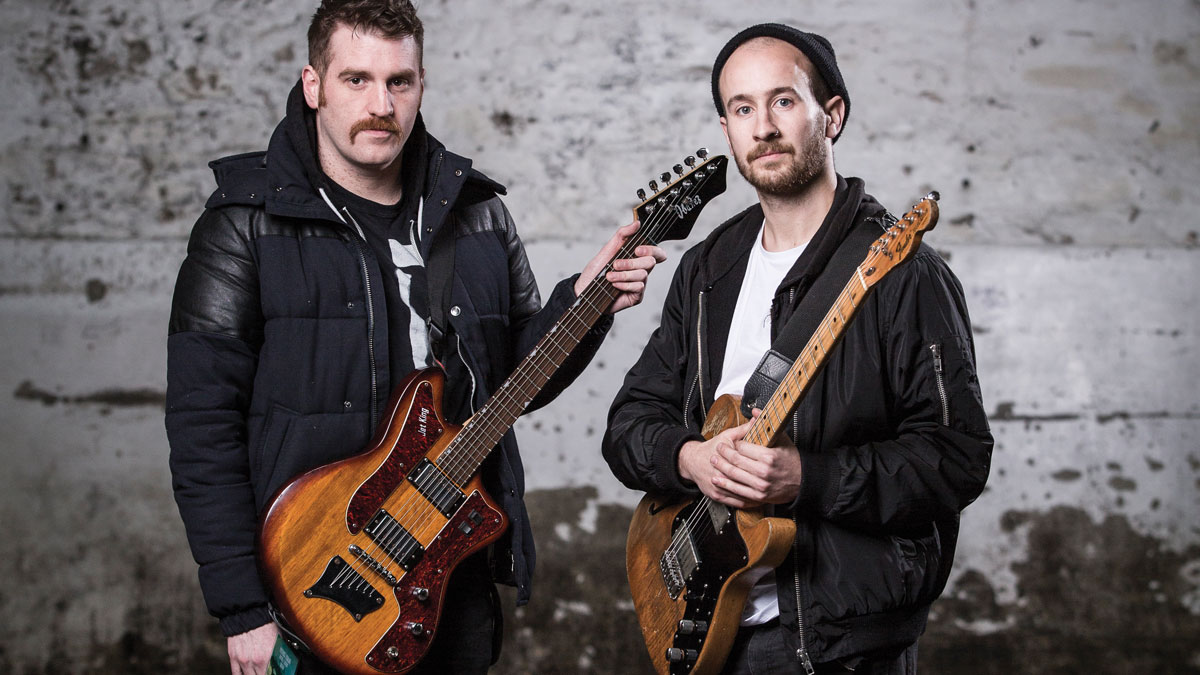
Introduction
(Mostly) instrumental rockers And So I Watch you From Afar crafted their most powerful statement of intent yet on this year's album Heirs, with a dazzling array of pedal-enabled tones and technique.
If you think instrumental rock falls into two camps - tech-heavy shred and meandering post-rock - Northern Ireland’s And So I Watch You From Afar are here to prove you wrong.
"There was a lack of vocals, we’d make up for it by sticking in a few more little intricacies in the guitar to compensate" - Rory
Through a combination of frenetic licks and impossibly catchy melodies, Rory Friers and Niall Kennedy have combined technique, melody and at least 10 pedalboards worth of stompboxes to forge a sound that’s unparalleled in their field - and as anyone who’s witnessed their live shows will attest, the band’s energy more than matches their attention to tonal detail.
We caught up with the duo to learn about the graft ’n’ gear that went into fourth album, Heirs...
Let’s start at the beginning: how did the band originally end up being a mostly instrumental outfit?
Rory: “It was a semi-conscious decision and a semi-practical decision. We’d come together out of the ashes of a few other grunge-y, punk-y bands that we’d been in in our teens, and none of those bands had ever got their act together to get a PA or a microphone.
“So whenever we’d start jamming, we didn’t really have any way to perform vocals, and over that first year, where there was a lack of vocals, we’d make up for it by sticking in a few more little intricacies in the guitar to compensate and make it a bit more interesting.
“It also coincided with being into a lot of instrumental bands, anyway. Bands on labels like Temporary Residence - noodle-y, math-y bands - and thanks to my dad, I grew up with a lot of prog music from the 70s, like King Crimson and early Jethro Tull.”
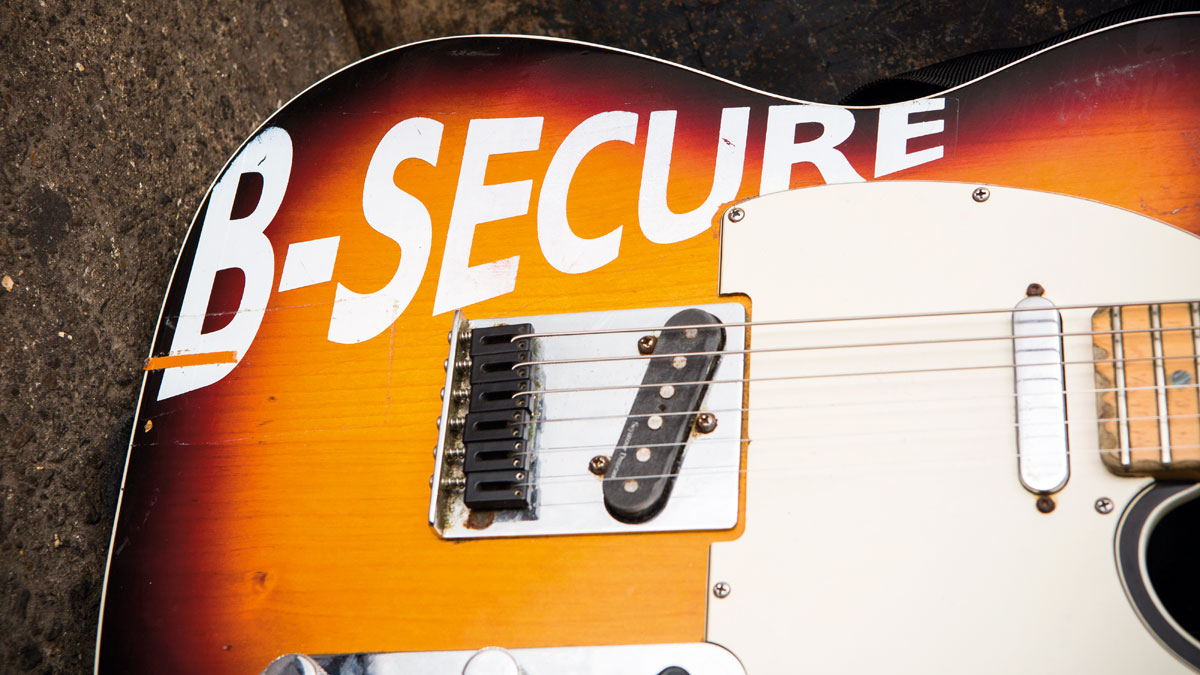
Brain melting MIDI madness
Heirs encompasses the best elements of all of ASIWYFA’s albums. What was the writing and recording process like?
Rory: “This time around, me and Niall have become more proficient in recording. We had some gear, we’d figured out how to record stuff and produce a bit, and so we locked ourselves away in our rehearsal room, set up a makeshift studio and approached it by recording everything, and chopping bits and piecing them together, and creating songs half in the room together, and half apart from each other.”
"We had an idea of something larger than just a barebones demo; there was stuff that we just dragged and dropped out of our sessions" - Niall
Niall: “Plus, not only were they there, but they were there and they were recorded to a really decent level. I remember the first week or two of being in the studio, and being like, ‘This doesn’t sound as good as the version that we’ve done!’ But then it was like, ‘Of course it’s gonna be as good.’ But it was all done, and not only like four-track, like hit record and play, but it was produced a little.
“We had an idea of something a little larger than just a barebones demo; there was loads of stuff that we just dragged and dropped out of our sessions, and dropped into the actual album.”
There are some complicated effects-meet-technique moments on the album. Were any of the tracks particularly difficult to play?
Rory: “We always have this joke about our RAM, our CPU, when it’s like, ‘I’m having a CPU spike! My RAM is full!’ You’re playing, you’re trying to remember all the effects you’re doing, you’re also trying to sing, and you kind of shut down.
"There’s some crazy shit going on at the minute - we’ve got two Line 6 [M9 and M13] pedals, and we’re looping stuff in sync" - Rory
“And then throw in the live scenario, where you’re trying to present a feeling of something to other people and tell them somehow that you’re in love with this, and you’re just like, ‘Urrr.’”
Niall: “And there’s some crazy shit going on at the minute - we’ve got two Line 6 [M9 and M13] pedals with a MIDI link connecting them, and we’re looping stuff in sync, and then resampling that.
“We were just at practice one day, and Rory had a MIDI lead for something else, and there was MIDI in/ MIDI out on the back of our pedals, and it was like, ‘I wonder if this works?’ And we plugged it in, and it was like, ‘Shit, that works!’ and then two songs ended up being on the album that use it [Redesigned A Million Times and Tryer, You].
“So, Rory’s triggering it, and later on in the song, it’s coming out of both our amplifiers at the same time, resampled, but then we’re also playing stuff at the same time, and singing...”
Rory: “...and changing the tempo, and forward or reverse. You have to get the sample so right at the start, and it’s only at the end of the song whenever you start triggering it again do you know that you’ve definitely got it exactly right, so it’s kind of nerve-wracking.”
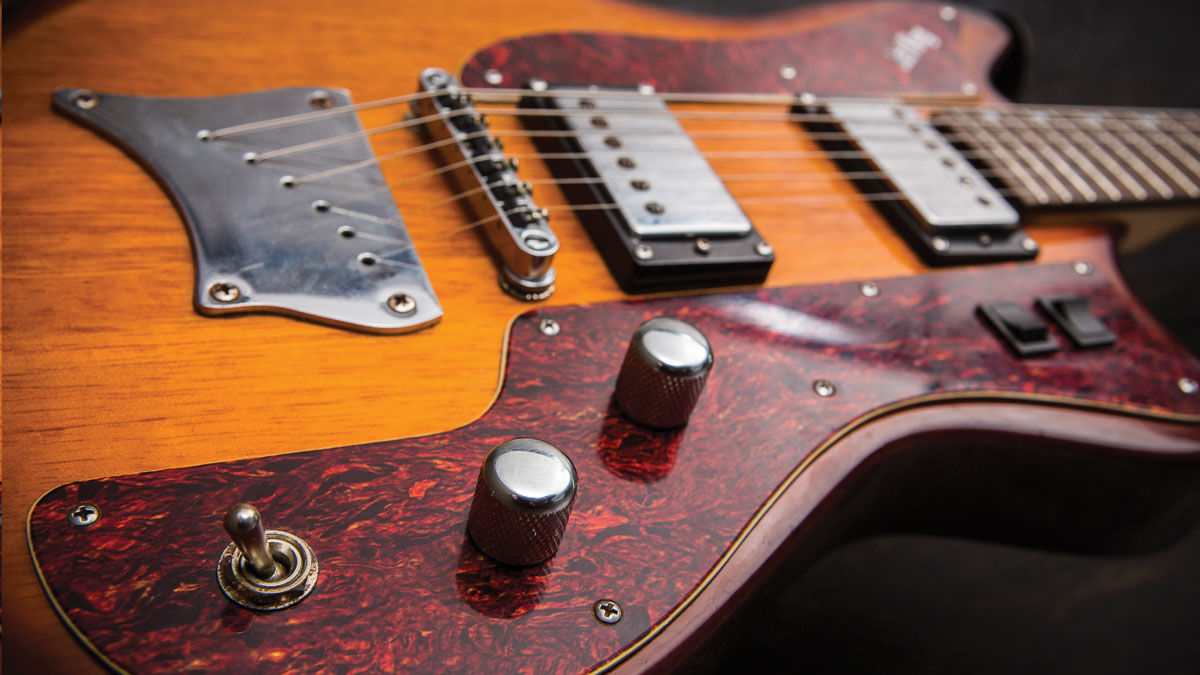
OMG Omar
What sparked your playing styles?
Rory: “There are a few guitar players that really changed the way I approached music, and one of them is Omar from At The Drive- In. Growing up, certainly for me, it was definitely not cool to be good on the guitar; I was playing in grunge bands and punk bands, and it was almost the worse you were, the better it was.
"It was cool to do stuff which is hard, and it can still be in this really energetic, punk- rock, visceral way" - Rory
“Secretly, I was in love with King Crimson, and I was in love with Led Zeppelin. But then I heard [At The Drive-In album] Relationship Of Command when I was 17, and it was just like, ‘There are all those things I love: they’re punk-rock as fuck and their shows are insane, but in among that, they’re incredible musicians. I can try and be good on my guitar, and it’s not Steve Vai; it’s Minor Threat, as well.’
“So, when I made that correspondence, then suddenly, it all just opened up, and for me, it was cool to do stuff which is hard, and it can still be in this really energetic, punk- rock, visceral way.”
Niall: “That Later With Jools Holland performance was a game-changer, where they played One Armed Scissor.”
Rory: “Ironically, where Omar only plays guitar for the first, like, minute of it.”
Niall: “It goes out of tune, so he throws it down and plays tambourine! But that was a huge game-changer for me, that moment - just seeing that was like, [whispered] ‘Wow.’”
There’s a very Celtic, Thin Lizzy-esque harmonised line in A Beacon, A Compass, An Anchor. Were they a big influence, too?
Rory: “We’ve had Thin Lizzy connections a load of times, and we’ve had the traditional Irish, too. I guess it all seeps in - we all grew up with it around us all the time. My dad’s a trad session musician and I grew up listening to a lot of Thin Lizzy. The greatest guitar solo of all time, hands down, is on The Rocker.”
What guitars were you using on the album?
Rory: “I switched back to using my US Tele [American] Deluxe - on the past 18 months’ touring, I’d gone to my other Tele, which is a semi-hollowbody ’73 Thinline - but it was difficult to tame if you were doing any choppy stuff, because you had to hit pedals on and off really quickly because it would just scream like crazy. With this record, because we were running our amps differently, I was getting that grit from the amps. There was another Tele Deluxe with humbuckers I used, as well.”
"I’ve had the same guitar for about eight years or more now, which is an Ibanez Jet King 2 reissue, which I really love" - Niall
Niall: “I used the Tele [American] Deluxe for loads of it, and then my friend brought in a Gibson - I think it was a Les Paul Junior. I’m used to playing battered piece-of-shit guitars, because that’s all I’ve ever really been able to afford, and I’ve had the same guitar for about eight years or more now, which is an Ibanez Jet King 2 reissue, which I really love, because it’s super-light.
“It doesn’t hurt you; you can have it on for ages. And it just sounds lovely. It’s got these Super ’58 Ibanez humbuckers in it. It’s just one of those guitars: the action’s really nice and low, you plug it in and it just works and sounds great.”
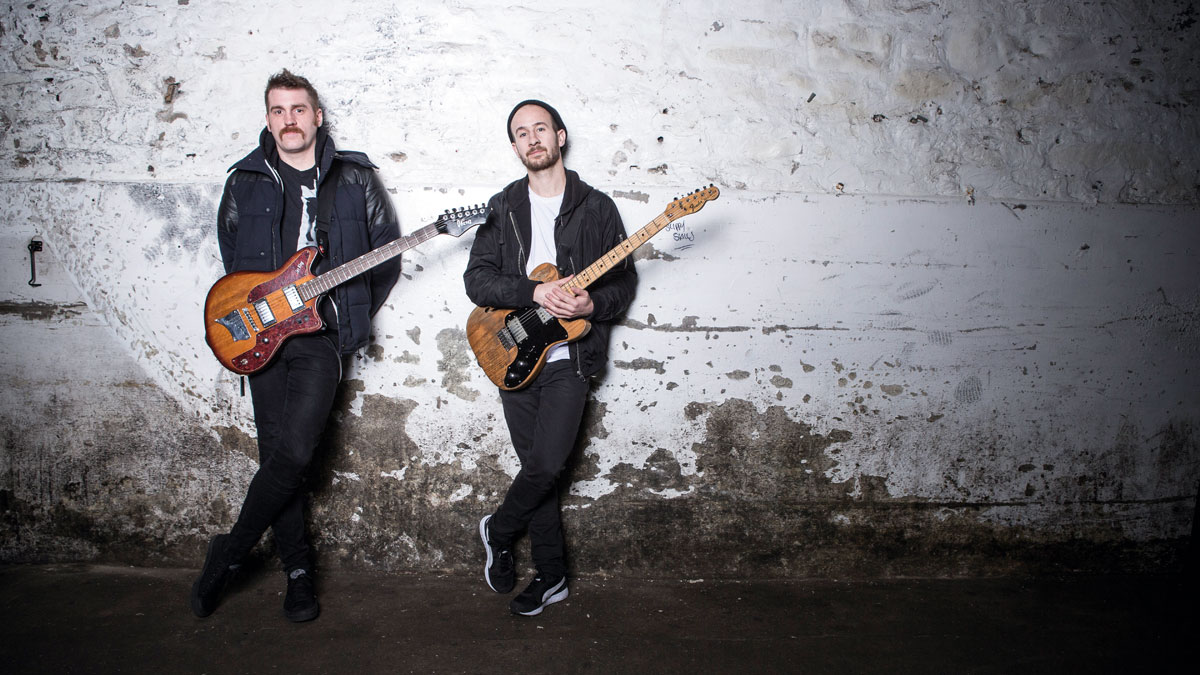
Boxes of inspiration
Were there any new pedals on the record?
Rory: “We’d like to give a shoutout to EarthQuaker Devices - because so many of the sounds on the new record are thanks to those guys. Actually, one of the best songs that didn’t actually make it onto the album is entirely because of them, with this pedal called the Arpanoid arpeggiator pedal.
"The Disaster Transport Sr by EarthQuaker Devices is gorgeous. You can just put it on and not play a string, and the sound of it being on is so nice" - Rory
“We just got the guitar and then Sellotaped an EBow onto it - so, it’s just one note, but you’ve got this [makes arpeggiator noise] and you can effect it by hand.
“Some of the other big ones would be the Disaster Transport Sr by EarthQuaker Devices, which is gorgeous. You can just put it on and not play a string, and the sound of it being on is so nice: it’s this modulating delay, and I love it.
Rory, you once had the idea of taping a ruler to your shoe to help with onstage pedal switching. Did that ever come to fruition?
Rory: “I just wanted to see if it would work, and it was like, ‘Yeah, that works; you can press three pedals on at once!’ The idea being that, with the front of your toe, you can just put on one pedal, but if you need to, you can get three in a row, no problem. But it isn’t worth it for just trying to walk around the room. You get a reputation of being a nark!”
What made you both fall in love with pedals?
Rory: “There were these bands I loved, and I didn’t know why... ‘Why does my guitar not sound like them? Oh, there’s reverb on this guitar.’ It’s like, ‘Reverb; right, tell me about that.’ Way before that, I got a distortion pedal and I was like, ‘Okay, now I’m awesome.’
"Every time you get a new pedal, you always write a new song straight away, because there will be some sound that you’ve never produced before"
“I realised that what I lack in virtuosity, I can make up for in sonic-ness. Then, it’s just a gradual thing: you come up with a song, you can pick up a guitar and play it, but once you know these things so intimately, you come up with a song and you know exactly what it can do. And then you think, ‘Well, let’s get another one on board, then,’ and that’s just kept happening.They’re just boxes of fun.”
Niall: “Boxes of inspiration as well - every time you get a new pedal, you always write a new song straight away, because there will be some sound that you’ve never produced before.
“You can play one chord and not have any inspiration, but you play it once with a new sound, and all of a sudden, it’s like, ‘Oh, shit!’ and something comes to you.”
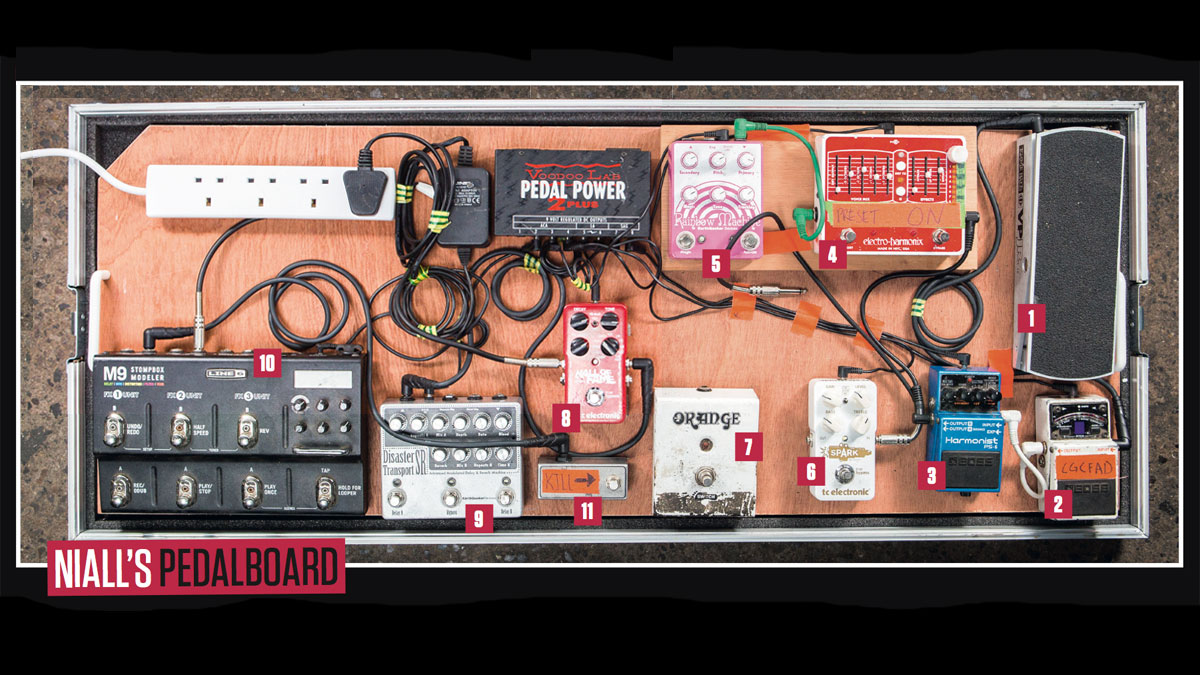
Niall's pedalboard
1. Ernie Ball VP Jr
“I just use that with delays and reverbs to do swells and things like that.
“And sometimes, I’ll have the POG on as well, which can get a big, thick low-end sound, and have loads of reverb and delay stacked and do big, huge swells.”
2. Boss TU-2 Tuner
3. Boss PS-6 Harmonist
“This does pitch modulation-type little bends, like in Big Things Do Remarkable I use it at the end and do a big pitch bend, and use it throughout the set in the same way a drummer would do a drum fill.”
4. Electro-Harmonix Pog 2
“I use the POG for all the octave stuff.”
5. Earthquaker Devices Rainbow Machine
“I just use it in the same way that I would use the Harmonist, for weird little drum fill-type things - I don’t know what the equivalent is for guitars!”
6. TC Electronic Spark Booster
“I’ve got the clean on the amp, and the Spark gives it just that little bit of grit.”
7. Orange Amp Footswitch
“The Orange distortion is the main distortion sound.”
8. TC Electronic Hall Of Fame
“I use the effects loop to stick in this reverb - I have that on church setting, just a big, huge sound, have the mix up real high, the decay up real high.”
9. Earthquaker Devices Disaster Transport SR
“This gives you that really beautiful tape echo-type delay sound.”
10. Line 6 M9
“I use this for all my delays, some of my reverbs, and then I also use a kind of rhythmic tremolo to create a choppy sound, a bit of a drum-fill sound at the end [of songs].”
11. Bright Onion Pedals Kill Switch
“Sometimes, it’s good to have a panic button, so you can completely kill everything, but I also use it to do a big crescendo and then [clicks fingers] to nothing. We’ll use it like that to make super-tight cuts.”
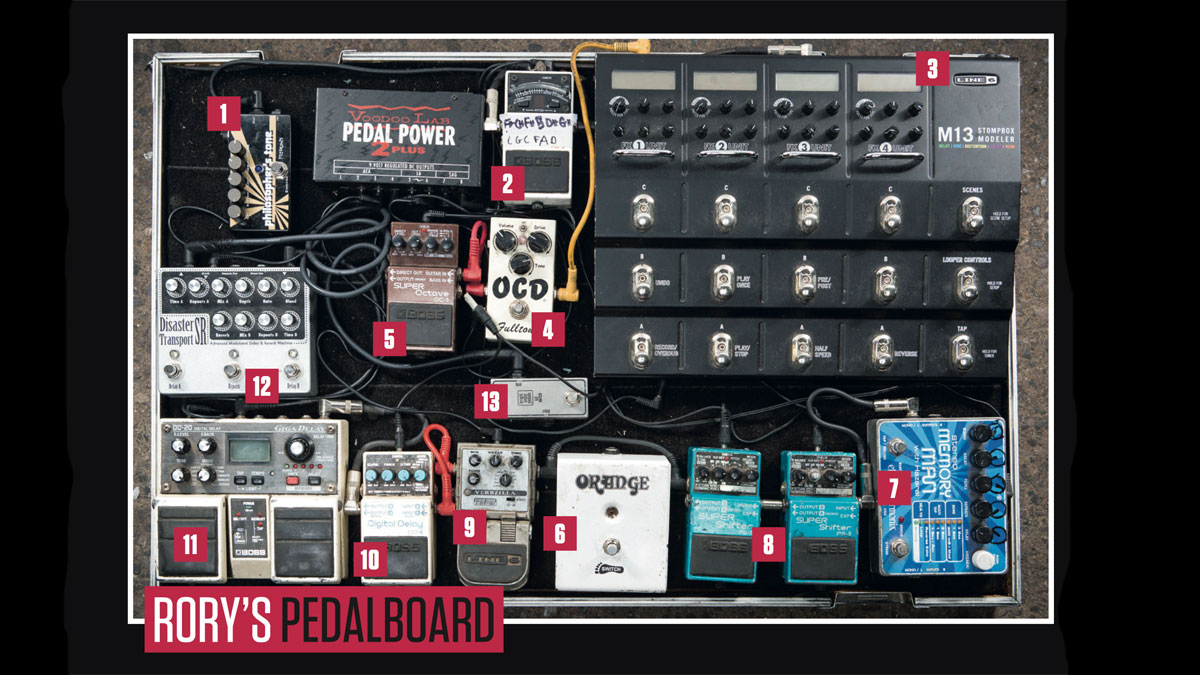
Rory's pedalboard
1. Pigtronix Philosopher’s Tone
“I found that for my clean stuff, I was digging into the strings and breaking a lot of strings, because my guitar wasn’t thick or loud enough.
“I wanted to work on my clean tone, so I bought this, and it’s solved all my problems. I have it on for 50 per cent of my show.”
2. Boss TU-3 Tuner
3. Line 6 M13
“Our last album had a lot of sounds, so it was impossible for me to make them all come on at the same time, so I had to resort to a multi-effects.
“And I was pleasantly surprised. I’d always had a bit of a thing - I guess a lot of people do - about multi-effects pedals, like they’re inferior, but for what I needed it for, it was great. And it has a looper in it, as well.”
4. Fulltone OCD
“My first gain stage is this OCD: you can have it quite subtle - a little gritty - or it works as a nice distortion if I’m ever doing any festivals where I don’t have my exact rig, and I might be using what’s at the festival.”
5. Boss OC-3 Super Octave
“This is just an octave pedal, really. I’ve had it for ages and it does the job.
“I use it less and less, actually, because I have a preset on the M13 that I really like, but I use this whenever I’m doing some volume stuff, like low volume-y stuff with some delay on.”
6. Orange Footswitch
“My amp is a Thunderverb 200-watt, and I use the two channels - clean and distortion - which I activate on this.”
7. Electro-Harmonix Stereo Memory Man with Hazarai
“I actually just have it on one setting, the 300-millisecond modulation, and have everything turned to turn it into this self-oscillating insanity, so essentially, whenever I press this button, it just creates this big, thunderous, cacophonous ‘reeargh’.”
8. Boss PS-5 Super Shifters
“I have one set to go from natural up to two octaves above in a big, long linear ‘weeeooorp’.
“And then I have the other one set to go up with zero attack, so it jumps from the natural sound to a 5th up, and I use this for this arpeggiation thing: I’m doing hammer- ons on triplets, and I’m pressing this on the beat. It makes it sound like I’m really good on the guitar.”
9. Line 6 Verbzilla
“I use it on a hall setting; sometimes I’ll have it full mix up, so it’s just reverb, sometimes not, but I usually don’t mess around with it too much.”
10. Boss DD-6 Digital Delay
“I have it set to loop: whenever you press and hold it the loop starts, and when you release it the loop ends.
“So, the shorter you do that, then the shorter the sample it records, so I use it to do little stuttery ‘brrrrp’ effects every now and again.”
11. Boss DD-20 Giga Delay
“I use it on a standard digital delay with tap tempo. I don’t really do anything very fancy with it.”
12. Earthquaker Devices Disaster Transport SR
“This is probably my favourite pedal on the ’board at the minute - it’s gorgeous modulating delay, set for really slow, really long delays, repeats up really high.
“You can just brush the strings and just let the sound of the pedal do the rest.”
13. Bright Onion Pedals Kill Switch
“It just makes everything stop, and we try and make everything sound tight: nice, straight cuts.”
Mike is Editor-in-Chief of GuitarWorld.com, in addition to being an offset fiend and recovering pedal addict. He has a master's degree in journalism, and has spent the past decade writing and editing for guitar publications including MusicRadar, Total Guitar and Guitarist, as well as a decade-and-a-half performing in bands of variable genre (and quality). In his free time, you'll find him making progressive instrumental rock under the nom de plume Maebe.


